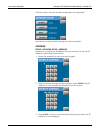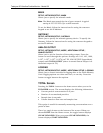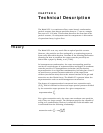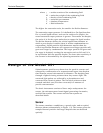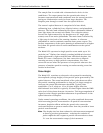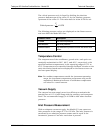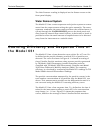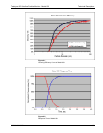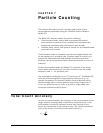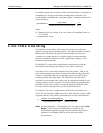
Teledyne API Ultrafine Particle Monitor - Model 651 Technical Description
07506C DCN6727 55
The sample flow is cooled with a thermoelectric device in the
conditioner. The vapor passes into the growth tube where it
becomes supersaturated and condenses onto the aerosol particles
(acting as condensation nuclei) to form larger droplets. The
droplets pass through a nozzle into the optical detector.
The sensor’s optical detector is comprised of a laser diode,
collimating lens, cylindrical lens, elliptical mirror, and photodiode
detector. The laser and collimating lens form a horizontal ribbon of
laser light above the aerosol exit nozzle. The collection mirror
focuses the light scattered by the droplets at a 90° angle (side
scatter) onto a low-noise photodiode. The main beam is blocked by
a light-stop in the back of the sensing chamber. A reference
photodiode is used to maintain constant laser power output. The
surface temperature of the optics housing is maintained at a higher
level than the growth tube to avoid condensation on the optical
surfaces.
The Model 651 operates in single particle count mode up to 10
6
particles/cm
3
. Rather than simply counting individual electrical
pulses generated by light scattered from individual droplets, the
Model 651 uses a continuous, live-time correction to improve
counting accuracy at high particle concentrations. Live-time
correction occurs when the presence of one particle obscures the
presence of another particle creating an undercounting error that
results in dead time.
Pulse Height
The Model 651 contains an electronic sub-system for monitoring
the amplitude (voltage height) of the particle pulse generated by the
optical detector. The actual amplitude of the pulse does not affect
the particle counting performance as long as it is large enough to
intercept the preset discriminator threshold. Typical pulse
amplitudes (1 to 2 volts) are 10 to 40 times higher than the
discriminator level which is typically 20 times higher than the RMS
noise level of the photo-detector electronics. This large magnitude of
‘signal-to-noise’ margin provides robustness in performance in the
optical detection of droplets.
Under normal operating conditions, the pulse amplitude decreases
with increasing particle concentration. As particle concentration
increases, depletion effects within the growth tube cause the
nucleated droplets to grow to smaller sizes than they would at lower
particle concentrations.
Note: The droplet size has been reduced in this instrument compared
to those of previous generations - reducing the variation in
pulse amplitude with respect to particle concentration to about
2:1 over the concentration range of the instrument.






